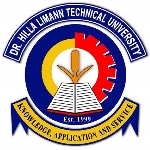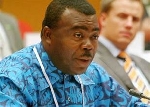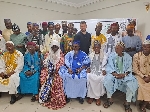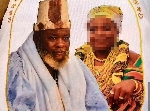Sisterhood of silence-breakers
 Esther Armah
Esther Armah
How safe are women from sexual harassment in Africa’s media houses?
How does sexual harassment in our media industry shape the reporting of rape? What impact does it have on individual journalists and the industry of journalism? Who do we lose because of sexual harassment? How does that loss shape our industry?
In Ghana, ‘suffer in silence’ can seem like a profession for women in the workplace when it comes to issues of sexual harassment. Too often, our approach has been – and is expected to be – ‘put up and shut up’ when it comes to behaviours that make women uncomfortable, that degrade, humiliate or dehumanize. We are expected not to speak up, report that person, tell anyone – but continue about the business of being in the media.
That should not be allowed to stand, nor should it be sustained. Indeed, it has been allowed to stand, and it has been sustained for too long.
It matters that we explore sexual harassment in our media houses from a number of specific angles. There is the cost and consequence to the individual journalist doing her job. There is an impact on reporting by women and men of stories on sexual violence and rape. There is the environment sexual harassment creates within media houses.
To those women in media houses for whom sexual harassment is your reality – what toll has this had, or is it having on you and your experience in our media industry?
So often, it is women who bear the cost and suffer the consequence. We must mourn and measure who we lose. There are those who have left jobs, quit jobs, been kicked out of jobs because of sexual harassment, because they couldn’t take it or because they did indeed speak up against it. There are those who have been denied promotion because of it. And there are those who have been given promotion, or a job because of it. We must be careful here not to conflate consent with coercion. We must also recognize that girls and women are taught their bodies can be currency, can be engaged in exchange for better treatment, a small piece of power – and so they use that to move and to manage.
And, of course, there are those perpetrators who have kept jobs, acquired promotions and climbed ladders where they continue to harass unchallenged. They can be a brilliant editor, a great leader or boss, a strategist, a champion of quality content-creation, a powerhouse to so many, and a sexual harasser to women. That too is our truth. It is a complicated one because from that space there is the instinct – and often the action – to protect the perpetrator and discard the victim. Why? One is seen as more valuable than the other.
I am a journalist, a proud one who loves my profession. I have been blessed to work and report on issues and stories here in Ghana, in Nigeria, Kenya and South Africa. Here in Ghana, I have had the blessing of engaging with multiple media houses for a number of stories, issues that are crucial. I have also heard story after story after story about sexual harassment. I am also a Media Communications lecturer, and sexual harassment in the media was a major concern for so many of my women students.
There is a whispering and a rumbling that occurs around the issue in our media landscape. It is not that there is no awareness, it is that action from awareness can trigger trouble. And no-one wants trouble, nor do they want to be labelled as a trouble-maker. The silence is strategic, and it is so often about survival.
Sexual harassment within media is a power that moves beyond the individual, it impacts the mic, the small-screen, the keyboard. That means it is an influencer. It influences the public – the readers, the viewers, the listeners – and their perceptions on sexual violence. It is this particular power that makes sexual harassment in our media houses especially egregious. It shapes a public as well as a person.
Journalism also faces particular challenges within our cultural African contexts. Women are taught not to question or challenge authority – these are the ‘good girls’. But journalism is about questions, it is about challenging. And then, in our same culture, if we reach back to the example of Ghana’s Yaa Asantewa, it was her challenge to her own community that led her to stand against the British. She questioned behaviour, and took a stance. She also ended up in Elmina – as well as our history books – a figure of resistance for whom there were dire consequences to her challenge. It’s an apt metaphor. Although the outcome in contemporary Ghana is clearly not so dire – the notion of questioning authority within our media landscape comes with repercussions that make silence understandable.
I wrote in this column last week about a ‘Brotherhood of Silence’, where men are raised and learn to be silent in the presence of actions that are harmful to women – that might be physical or sexual harassment or violence. It matters too that we speak about a sisterhood of silence-breakers, courageous women who choose to speak truth to power, who fight, engage, organize, challenge and advocate. They do so individually, through collectives, in community and via organizations.
In Ghana there is the Alliance of Women in Media Africa (AWMA); in Kenya, there is the Association of Media Women in Kenya (AMWIK); in Tanzania there is the Network of Media and Public Relations (TWMPR); in Nigeria there is the Nigeria Association of Women Journalists, and there is African Women in the Media (AWiM). Each of these collectives organizes and advocates for women in media’s professional development, and also organizes in the fight to eradicate sexual harassment in their media environment.
This sisterhood is stretching across nations and waters to engage and exchange, to build and break-through. This work is crucial. It too comes with cost and consequence. And it may seem an insurmountable hurdle given the pervasiveness of sexual harassment in too many African nations, and in too many of our media houses.
Earlier this year, I attended the African Women in Media (AWiM) Conference and Festival in Nairobi, led by award-winning journalist Dr. Yemisi Akinbobola. I was on a panel with journalists and media practitioners from Kenya, Ghana and America called ‘#MeToo in Africa: Sexual Harassment & Global Movements’. One of the panelists, a Kenyan journalist Rachel Ombaka, spoke of four specific ways sexual harassment occurs in newsrooms and media houses in her presentation; unwanted touch or tight, tight hugs, groping, lewd jokes about your body and unwanted kisses.
“Sexual harassment in newsrooms silences voices of people who would otherwise have remained confident. It leaves them withdrawn, anxious, angry, ashamed and often looking for the next exit out of the media industry,” Rachel explains. Powerful. And painful.
Media is my industry. It is our industry. It is part of a nation’s mirror to what is wrong, what needs highlighting and what needs to change. It is beyond time for our media to mirror its own actions, to look internally, to make change.
It is indeed beyond time to make media houses safe for all journalists to flourish. That is not just good and right for an individual, it is crucial for an industry with so much influence.
Be sexual harassment-free. Be better. Be safer. For all of us, not just some of us. Let’s continue to build a sisterhood of silence-breakers together, in solidarity, in community with our brothers, with compassion and courage.
#TimesUpAfriMedia for #16DaysOfActivism: 25th November – 10th December.
#TimesUpAfriMedia is a multimedia campaign on sexual harassment in Africa’s media houses for the UN’s #16DaysOfActivism from the International Day for the Elimination of Violence Against Women on 25th November to International Human Rights Day on 10th December. Created and led by EAA Media Productions with Kenyan journalist Rachel Ombaka, in partnership with African Women in the Media (AWiM); Biola Alabi Media, Nigeria; Media Council of Kenya, Association of Media Women in Kenya (AMWIK); Network of Media and Public Relations, Tanzania. The campaign includes Video, Twitter-Chat, On-TV and On-Radio Discussions in Ghana, Nigeria, Kenya.
Source: Esther Armah| [email protected]
Trending News

Man held for robbing late vice president's widow of ₵28,000, £50, and $2,200 at gunpoint
13:06
Hilla Liman University begs for students accommodation
01:10
Gov't plans to revise traditional customs following controversial Gborbu marriage
08:30
Fuel prices up: Petrol, diesel sell at ₵14.99, ₵14.80 per litre
11:49
EC interdicts five officials over missing BVDs
13:33
Labour threatens strike over unpaid pensions
08:18
Police arrests trucker for Tema-Mpakadan rail accident
08:12
USAID sharpens leadership skills of 70 Fulbe chiefs
11:09
Int'l Medical Lab Science Day: Amend relevant laws to improve the regulation of our profession – GAMLS to gov’t
13:37
Naa Okromo not pregnant – Gender minister-designate says she'll be reunited with her parents
20:33



